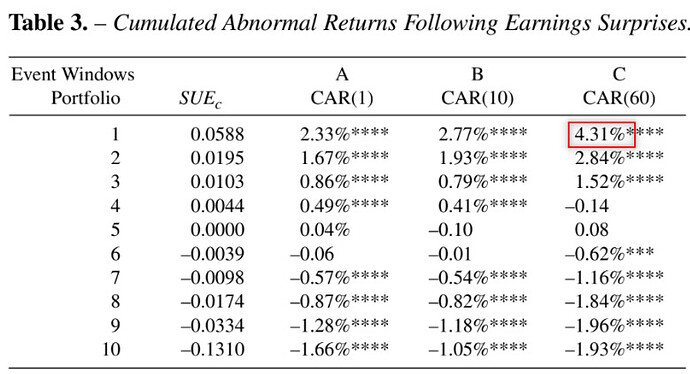Dear All,
we just released many new factors related to Standardized Unexpected Earnings (SUE) mentioned in this post by @WalterW. General formula for Standardized Unexpected factors is
SU = (ACTUAL - ESTIMATE) / STDDEV
More in depth documentation is coming. Please note that Standardized Unexpected Sales (SUS) doesn’t really exist in literature (as far as we can tell) but seems to help in rankings.
The new factors are all in the ESTIMATES section. They are:
SUEQ1 SUEQ2 SUEQ3 SUEQ4
SUEY1 SUEY2 SUEY3 SUEY4
SUSQ1 SUSQ2 SUSQ3 SUSQ4
SUSY1 SUSY2 SUSY3 SUSY4
Return SUE / SUS for the previous 4 Interims (Quarters or Semi Annuals) and 4 Years. We constrain prebuilt factors to -10 to +10 since values outside this range do not seem to correlate to additional predictive power. Values below and above are set to -10 and 10 respectively.
The new functions are
EPSSUE(offset,type [,constraint])
SalesSUS(offset,type [,constraint])
Return SUE / SUS for the period. For example EPSSUE(0,QTR) is equivalent to SUEQ1. Constraint parameter defaults to 0, which means no constraint is applied.
EPSHistEstSD(offset,type)
SalesHistEstSD(offset,type)
Returns the standard deviation of the estimates for past periods. This is the last value before the announcement.
EPSHistEstCnt(offset, type)
SalesHistEstCnt(offset,type)
Returns the number of estimates for past periods. This is the last value before the announcement.
ConsEstStdDev(cons_item [, period, weekAgo])
This function is unrelated to the above, it was missing (an oversight) from ESTIMATE FUNCTIONS. It returns the SD for upcoming period.
Let us know what you think
Thanks!

